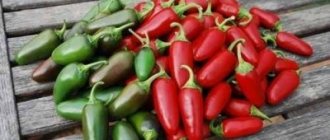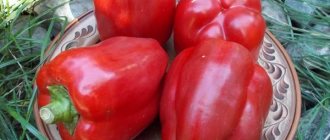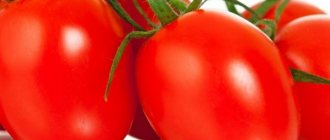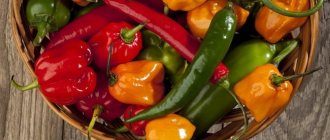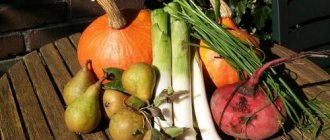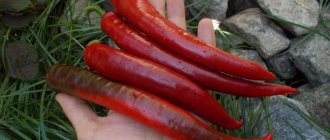Jalapeño - what is it? A wonderful name for a vegetable, isn't it? This pepper has been in space as the favorite seasoning of American astronauts. Almost every Mexican dish uses Jalapeño. Spicy lovers in our country are familiar with this pepper.
How to grow, where to use, photos and many other interesting things about Jalapeño peppers can be found in our article.
What kind of pepper is this
Jalapeño is a variety of vegetable pepper (lat. Capsicum annuum). It got its name from the Mexican city of Xalapa, where it is mainly grown.
What it looks like, how and where it grows
Jalapeño pepper is a bushy plant up to 1 m high with branched stems, elliptical leaves and white to grayish flowers. The fruits are small, from 5 to 9 cm in length; 25-35 even, conical-shaped peppers with thick, juicy walls are collected from one plant per season.
Technically ripe green fruits are valued; Peppers that are overripe and have a red color are not used; in extreme cases, they are dried or smoked.
The most extensive plantations of the crop are located in Mexico. This pepper is also widespread in the southern states of the USA: New Mexico and Texas.
This is a heat-loving plant, so in Russia amateurs grow it in greenhouses and on window sills.
Taste and aroma, spiciness
Jalapeño has a characteristic sour taste. The degree of pungency, depending on the conditions and place of growth, varies from strong to hot. On the Scoville scale it ranges from 2500-8000 units. For comparison, sweet bell pepper - 0 units, red hot pepper (chili pepper) - from 30,000 to 50,000 units.
The sharpest parts of the fruit (due to the high content of capsaicin) are the seeds and the inner membrane. After removing them, the pepper's spiciness decreases.
Planting Jalapeño Peppers
There were 35 seeds in a two-gram bag. This amount is more than enough. For testing, I sowed 5 of them in the prepared soil for seedlings, having previously soaked them for a day in a 1% solution of potassium permanganate.
I sown the seeds in early March, deepening them 1 cm so that they do not rot in the soil. After spraying the soil with water from a spray bottle, I covered the container with film and placed it on the windowsill. A week later, the first shoots appeared: out of 5 seeds, 3 sprouted. By the way, this year the sweet pepper seeds had to be sown in a new way, because... For some reason the first ones did not rise.
A month later, the grown seedlings were picked and each plant was transplanted into a separate pot. Two peppers got containers with a volume of 5 liters, one - a little less. A layer of expanded clay was placed on the bottom of each, and soil on top, which was used for growing seedlings.
You can prepare the soil for peppers yourself. To do this, you need to mix garden soil, lowland peat, river sand and agroperlite (in a ratio of 5:3:2:5). Before use, the soil must be disinfected (you can calcine it in the oven or spill it with a weak solution of potassium permanganate).
I placed the pots on the windowsills, because jalapenos are not afraid of direct sunlight. My windows face southeast, so the plants felt good there and quickly began to grow. They bloomed in April, and the first peppers appeared already in May, and on the lowest bush, which grew in a smaller pot.
Peculiarities
Jalapeño peppers are valued for their high content of nutrients. It adds moderate heat and piquancy to various meat, vegetable dishes and sauces. Eating this type of pepper causes an unusual sensation of warmth, followed by an increase in pungent taste in the mouth.
Composition, properties, KBJU
Jalapeño contains a large amount of essential oils, vitamins E, A, C, and group B.
It contains carotenoids, trace elements sodium, calcium, magnesium. Due to the relatively low content of capsaicin, it does not have a pronounced burning taste: if you try the pepper, the burning sensation on the tongue will quickly pass.
In terms of 100 g of product, caloric content is 30 kcal, protein content is 1.35 g, fat is 0.62 g, carbohydrates are 5.91 g.
Harm and benefit
Jalapeño peppers have many beneficial properties.
The substance capsaicin, which causes a burning taste, thins the blood and helps normalize blood pressure.
This product has a positive effect on metabolic processes and helps digest heavy protein foods. Eating pepper produces endorphins, improves mood, and normalizes sleep. Jalapeño strengthens the immune system; regular use in food improves the condition of the skin and hair.
However, if you consume this type of pepper in large quantities, you can damage the gastric mucosa.
Contraindications
People with individual intolerance, kidney, liver, and gastrointestinal tract diseases should not eat Jalapeño peppers. The consumption of spicy foods is contraindicated for children, pregnant and lactating women.
Contraindications and possible harm of jalapeno
In countries where residents consume hot fruits from an early age, certain rules for eating this product have been formed over the centuries. They take into account gender, age, plant variety, compatibility with other foods, etc.
A person who has not previously eaten such hot peppers may not only not get the benefit, but also harm the body.
Possible negative consequences of using this product include:
- exacerbation of gastrointestinal diseases, heartburn;
- diarrhea;
- burn of mucous membranes.
Hot pepper is contraindicated:
- for stomach ulcers, gastritis, colitis, enteritis;
- diseases of the genitourinary system, liver, kidneys;
- inflammatory processes in the larynx, throat, oral cavity;
- allergies.
Taking jalapenos is prohibited for children, pregnant women and breastfeeding women. And the main thing in eating pepper is moderation.
Application
Cooking is the main use of Jalapeños. But the burning components contained in the fruits make it possible to use it in medicine and cosmetology.
In cooking
There probably isn't a Mexican dish that doesn't have Jalapeño in its recipe. It is added to salads, vegetable and meat dishes, and soups. Fresh peppers are used in tomato-based condiments and sauces.
A feast for a gourmet - stuffed Jalapenos. For example, pepper pods are stuffed with grated cheese and decorated with rings of the same spicy fruit.
In European countries, pickled peppers are used. They are added to main courses, soups, and pizza.
The popular soft drink sangrita also contains this green hot pepper.
In addition, dishes with the addition of Jalapeño remain fresh longer.
In folk medicine
Tinctures that improve appetite are prepared from Jalapeño peppers. They are also recommended for use for insomnia.
In cosmetology
Thanks to vitamins and substances that improve blood circulation in the skin, Jalapeño is considered an excellent ingredient in anti-hair loss masks and anti-cellulite products. Having antibacterial properties, baths with this pepper reduce sweating of the feet.
Attention ! The use of cosmetics containing Jalapeño is not recommended for people with hypersensitive skin. If there are wounds or cracks, you should also wait a little while using such products.
Beneficial properties of pepper
Jalapeño has a number of advantages over other hot peppers:
- Moderate spiciness. Hot varieties of chili peppers can cause burns to the mucous membranes of the tongue, larynx, and eyes from one touch, while a couple of jalapeno peppers will not cause harm to health.
- When dried, pickled and other culinary treatments, jalapeno does not lose its taste, and often improves it. It is easy to increase or decrease the pungency - just leave or remove the seeds and internal partitions of the fruit.
- In hot countries, pepper is added to food to extend shelf life - the product suppresses the proliferation of pathogenic flora. And its pleasant taste adds piquancy to dishes.
- When jalapenos are consumed together with heavy foods, such as grilled meat, the secretion of gastric juice increases, making digestion easier.
- Improves appetite, removes parasites.
Watch the video:
Growing
A stranger with a sharp character is not whimsical; it is quite possible to grow him on a personal plot or windowsill. The agricultural technology for growing Jalapeño is no different from that used for the usual sweet pepper. At home it is grown as a perennial.
Features of care
Planting is done using seeds. It is better to buy them in specialized gardening stores. Before planting, the seeds must be pickled in a one percent solution of potassium permanganate for 20-30 minutes. Germinate the seeds on moistened gauze for 24-48 hours, avoiding drying out.
Planting both for seedlings and for cultivation at home is carried out in March-April.
To grow Jalapenos, use loose, nutritious soil with good drainage. Ready-made soil for flower or vegetable crops is ideal. Seeds should be planted to a depth of 1-1.5 cm; if planted deeper, they may not germinate.
Seedlings grow in 45-75 days. Jalapeño is heat-loving and afraid of cold and drafts, so boxes with seedlings are covered with film until shoots emerge. Then the film is opened briefly at first and the ventilation time is gradually increased. After several days of hardening, the film is completely removed. It is necessary to water the seedlings moderately but regularly. The first feeding is carried out 10 days after emergence.
When the plant acquires 2-3 pairs of true leaves, it is transplanted to a permanent location. To do this, take a plastic or ceramic pot with a volume of at least 5 liters. The soil used is the same as for planting seeds.
To grow peppers in your personal plot, it is better to organize a greenhouse. Seedlings are planted in the ground in late May - early June.
When the sprouts reach a height of 15-20 cm, they are pinched so that the bush branches.
Flowering and fruit formation occurs throughout the summer.
Watering is carried out as the soil dries, but at least 2-3 times a week with settled warm water.
For growth and fruiting, Jalapeño requires microelements: nitrogen, phosphorus, potassium. Fertilizing is carried out at least once every two weeks with complex fertilizers - superphosphate and potassium humate. They should be used according to the instructions.
The most comfortable conditions for the plant are at an air temperature of 24-28ºС, in a bright, draft-free place.
Caring for a plant in winter at home has its own characteristics. After flowering and fruiting, a period of rest begins. Bushes slow down or stop growing, partially or completely shed their leaves. At this time, the pots with pepper are moved to a cool place with a temperature of 12-18ºС, fertilizing is stopped, watering is reduced to once a week.
In the spring, with the end of the dormant period, the plants are returned to a warm place and fertilizing and watering are resumed.
Diseases and pests
Jalapeño peppers are most commonly susceptible to blackleg and blossom end rot. Blackleg attacks seedlings. The stems become thinner and the leaves fade. The disease occurs when overwatering or using cold water. With blossom end rot, the fruits become covered with black spots. Causes of the pathogenic process: lack of calcium, excess nitrogen and insufficient watering.
It is a mistake to think that hot pepper varieties are not susceptible to pest attacks. Aphids, whiteflies, and spider mites are found on Jalapeño bushes.
To get rid of them, insecticides or folk remedies are used:
- An effective remedy against aphids and whiteflies is an infusion of garlic and dandelion . To prepare it, take one tablespoon of chopped garlic and dandelion stems, add water and leave for a day, filter and spray the bushes.
- To combat spider mites, use a solution of ammonia and laundry soap. For 1 liter of water, take 1 tablespoon of ammonia and a spoonful of grated soap, stir thoroughly and treat the plants, covering the soil so that the solution does not get on it.
Diseases and pests
Due to the pungency of the fruit, the plant is not susceptible to pests. When growing a plant at home, spider mites may appear. It is washed off with water and the pepper leaves are wiped with damp cotton wool.
Gardeners love the Jalapeño pepper for its unpretentious cultivation. The plant is thermophilic. Responds well to fertilizing and fertilizers. The fruits are very beneficial for the human body and contain essential vitamins.
If you find an error, please select a piece of text and press Ctrl+Enter.
Collection and storage
The bushes bear fruit throughout the summer. Green peppers 5-6 cm long are collected. Over the course of several weeks, the fruits turn red, become sweeter, and their pungency decreases.
Important ! When collecting and laying, use gloves, as plant sap causes skin irritation.
Fresh pods are stored in jars in the refrigerator or cellar for no more than 14 days, and dried Jalapenos are stored in an airtight glass container in a dark place. Pickled peppers are suitable for long-term storage.
Making spices
To make spices, Jalapeños are dried and, if necessary, crushed.
Pickled hot peppers are an excellent seasoning for various dishes. A classic marinade of wine vinegar, sugar and salt preserves the natural flavor of the pepper.
For 15 Jalapeño pods, prepare a marinade with the following proportions:
- 240 ml white wine vinegar;
- 240 ml water;
- 4 tbsp. l. Sahara;
- 2 tbsp. l. salt.
Caring for jalapenos at home
As the peppers ripen, they turn dark green
I should immediately note that all three plants are different from each other. Two of them: one 30 cm tall, the second about half a meter, produce fruits characteristic of the variety. These are dense, fleshy peppers with blunt ends up to 8 cm long.
But the third plant surprised me: it grows thin curved fruits 10-14 cm long. I suspect that this is Cayenne pepper or one of its varieties - Hot Bouquet.
Cayenne pepper
All three plants turned out to be undemanding in care. I regularly watered them in the evenings with filtered water at room temperature, and fed them every two weeks with potassium humate (5-10 ml per liter of water).
Jalapeños don't like chlorine, so don't douse them with tap water. Also avoid over-wetting the soil, which can lead to root rot.
This year June turned out to be hot, so I put the plants on the open balcony, where they were well ventilated and received a dose of sunlight. Sometimes they even spent the night there.
Bees periodically flew onto the balcony, so that up to a dozen peppers grew on each bush at the same time. Although I noticed that plants reproduce without the participation of these insects, while in the apartment. They continue to bloom on the windowsill in September and form new ovaries.
My bushes grew relatively small, so they did not need supports or garters.
Sowing seeds
In our opinion, indoor pepper seeds can be sown at any time. The only caveat: when sowing during periods with short daylight hours, additional illumination will have to be organized.
Preparation of seed material
Seeds are purchased in specialized stores or collected independently. In the latter case, healthy fruits that have reached biological ripeness are used to obtain quality seed. They are divided in half, the seeds are selected and dried in a warm, dry place.
Self-obtained seed material is disinfected. It is soaked for 20 minutes in a slightly pink solution of potassium permanganate. To speed up the emergence of seedlings, pepper seeds are germinated:
- Take 2 cotton pads, wet them and then squeeze them out.
- Disinfected seeds are placed on one disk and covered with the second.
- Transfer the discs to a shallow container. If there is no lid, you can cover the dishes with cling film.
- The container is placed on a bright windowsill.
- The condition of the seeds and discs is monitored daily. If necessary, moisten them with a spray bottle. To speed up germination, in our opinion, it is advisable to add a growth stimulator (Epin, Kornevin).
- As soon as the seeds hatch, they are sown in pre-moistened soil. In dry conditions they will die.
If the seed does not hatch after 10 days of germination, it is still sown. Otherwise, the seeds may begin to rot.
Soil requirements
Pepper does not like acidic soils. For it, loose soil with a neutral reaction should be used. A universal primer purchased in a store will do. You can compose it yourself from high non-acidic peat, humus (vermicompost) and river sand (in equal proportions). An alternative option is to mix turf soil and coarse river sand. Self-prepared soil must first be disinfected by steaming it in a steam bath or calcining it in the oven for 20 minutes (at 200 °C).
Sowing technology
To avoid intermediate picking, use containers with a volume of 3 liters. They should have drainage holes at the bottom. Sowing instructions:
- If the container does not involve picking into another, then a drainage layer is laid on the bottom.
- Fill the pot with substrate.
- Make a hole in it and moisten it.
- Lay out a few seeds and sprinkle with soil.
- Moisturize again.
- The containers are covered with glass to create the required level of humidity.
- It is removed regularly to ventilate the soil and, if necessary, moisten it. Seeds germinate at temperatures above 13°C.
- When the shoots appear, the glass is removed completely.
When sowing seedlings in a common box, leave a distance of 5 cm between the seeds. This distance is enough to prevent the roots of young seedlings from intertwining. But you can’t delay picking. It is carried out immediately after the formation of two true leaf plates.
Spider mite test
the spider mite tried
At home, the main enemy of jalapenos is the spider mite. And this misfortune did not pass me by. All three plants developed characteristic markings on their leaves.
Having had a sad experience with roses given in a pot, which could not be saved either with laundry soap or spraying with an insecticide, I immediately turned to specialists for help. It was recommended to use a drug with the active ingredient aversectin C (Actofit).
It only took two sprays with the solution (5 ml per 1 liter of water) with an interval of 10 days for the pest to no longer appear. In memory of him, traces of his vigorous activity in the form of dots and white spots remained on individual plant leaves.
spider mite marks
To avoid a recurrence of the incident, I regularly sprayed the plants with water from a spray bottle.
Description of culture
The jalapeno pepper belongs to the genus of chili peppers and is the hottest pepper in the world, having an international heat index rating of 2.5 to 8 thousand points. Green pepper pods are eaten fresh; for this it is important to collect them at the right time. If the moment of ripening is missed, the peppers acquire a dark red color; such pods are dried, crushed and used as a seasoning. The average length of pepper is 5-6 cm, there are specimens up to 9 cm. Jalapeño is a perennial crop, trees with pepper grow up to 50 cm. Gardeners have noted the dependence of growth and fruiting, on low bushes the pods grow more actively, up to 50 peppers per season from one tree . The flavor feature of jalapeno is a gradual increase in heat, so be careful with the amount of vegetable in the dish: at the beginning it may seem that there is not enough pepper. Jalapeño peppers are rich in enzymes and substances that stimulate metabolism and improve the functioning of the gastrointestinal tract. But due to its high irritant potential, the use of pepper in food in the presence of allergies or gastritis is undesirable, so as not to provoke an exacerbation of the disease.
How to pickle jalapenos?
The process of preparing pickled jalapenos is practically no different from preparing other preserves. However, there are a few tricks:
- for the marinade, use no more than 2 additional types of spices;
- to reduce the pungency, soak the vegetable in milk overnight or pour boiling water over it 10 minutes before cooking;
- Do not add iodized salt to the marinade.
The finished peppers are piquant and tasty. They can also be added to sauces and stews.
Benefit
Photos of jalapeno peppers can be found in reference books on traditional medicine and proper nutrition.
Due to the fact that the fruit contains useful substances, pepper has the following beneficial properties:
- immuno-strengthening;
- antidepressant;
- painkiller;
- antiviral;
- antimicrobial;
- stimulating digestion.
Jalapeño on the windowsill
If it is not possible to grow peppers in the garden, jalapenos can also be grown in a pot on the windowsill. It will perform quite well even in a 3-liter container. However, this is an outdoor plant, so the larger the pot, the higher the yield.
It is necessary to feed plants in pots at the same time as when growing in open ground, but with fertilizers in a lower concentration (2 times). And only at the moment of fruiting begins, fertilizing with complete fertilizer with the formula N:P:K 3:11:38 is suitable.
It is better to allocate a place for potted peppers on a sunny windowsill. But in addition to watering and shaping, in these conditions they will also need careful inspection for pest damage. Indoor peppers are often attacked by aphids and spider mites. If you do not fight them, the plants are oppressed and die. Therefore, when the first signs appear, it is necessary to use chemicals and process the jalapeno according to the instructions.
How can you tell if a pepper has been attacked by aphids? First of all, small insects will be found on the ends of the shoots and young leaves, and a sticky coating will appear on the foliage. The fact that peppers are being attacked by spider mites can be determined by the characteristic small white dots on the surface of the leaves and cobwebs in the upper forks of the stem. The insect itself can be seen on the cobwebs and the underside of leaves under a magnifying glass.
Composition of pepper and its types
Jalapeño is not only tasty, but also very healthy, as it contains many essential oils. Pepper pulp contains the following beneficial substances:
- vitamins: A, B2, B6, C, E, P;
- sugar;
- piperidine;
- chavicin;
- carotene;
- fatty acids - Omega-3 and Omega-6;
- minerals: phosphorus and iron, potassium and magnesium, calcium;
- acids - linoleic and linolenic.
The hot vegetable has several varieties.
The description and taste of varieties differ depending on the region in which they grow
These varieties are the most famous and most commonly used:
- Espinalteco - pepper with pointed pods;
- Morita - the most famous variety in the CIS countries, has round-shaped fruits;
- Peludo is a pepper with long and very fleshy pods.
Additional Information! In Mexico, the homeland of pepper, it is called “bully” because of its taste - the sharpness and pungency when eating the vegetable does not appear in the mouth immediately, but after some time.
Advantages and disadvantages
Pros:
- long fruiting;
- significant productivity;
- excellent taste and product properties;
- drought tolerance;
- good preservation on bushes and in assembled form;
- increased level of valuable components (antioxidants, vitamins, microelements);
- beautiful appearance;
- convenient sizes;
- dense and juicy internal consistency;
- stress resistance.
Minuses:
- does not like drafts and shade.
